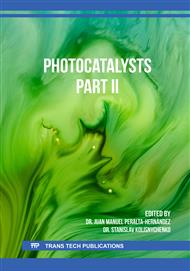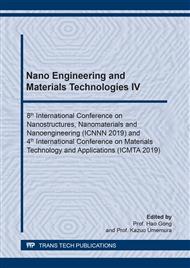p.106
p.111
p.117
p.127
p.133
p.139
p.144
p.149
p.155
Influence of Different Preparation Methods of Silver-Modified Carbon Nitride on the Photocatalytic Activity towards Indigo Carmine Dye
Abstract:
Silver nanoparticles (Ag NPs) may increase photocatalytic activity of widely used photocatalysts under visible light irradiation and decrease recombination probability of photogenerated electrons and holes. In this paper, we report three different preparation methods to obtain Ag/C3N4 nanocomposites. We used Ag nanoparticles a) synthesized by using sodium borohydride, b) synthesized by using UV 365 nm LED and c) already prepared and purchased from company nanoIron. The Ag NPs have been loaded on thermally exfoliated carbon nitride with the aim to form 5 wt.% Ag/C3N4 nanocomposites. Further their photocatalytic activity was tested towards Indigo carmine dye (IC) under 416 nm LED. The results show that method a) loaded different amount and size of Ag NPs on the surface of C3N4, b) changed optoelectronic behaviors of nanocomposites and c) significantly influenced their photocatalytic activity.
Info:
Periodical:
Pages:
133-138
Citation:
Online since:
May 2020
Keywords:
Price:
Сopyright:
© 2020 Trans Tech Publications Ltd. All Rights Reserved
Share:
Citation:



